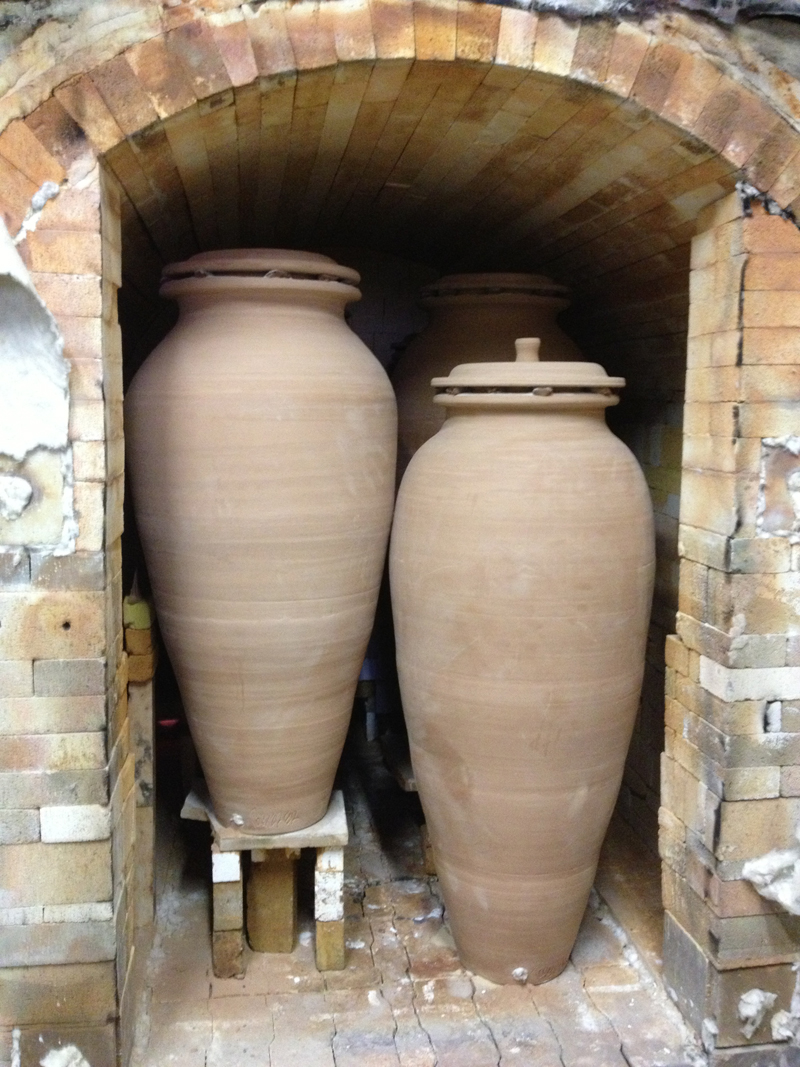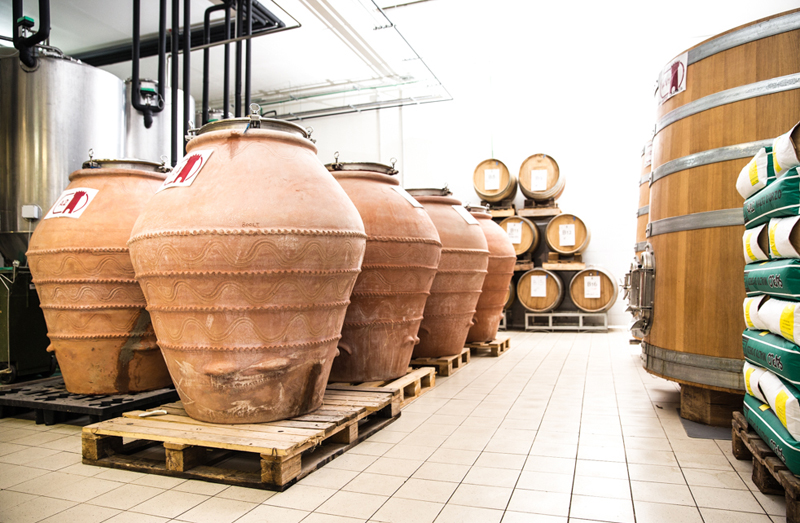Amphora-Aged Beers: The Next Small Thing?
Renowned for his traditional lambic production at Brasserie Cantillon in Brussels, Belgium, Jean Van Roy found inspiration during a blind wine tasting a few years ago, prompting him to take his brewing a few thousand years further back in time.
Some of the Italian wines he sampled had been matured in amphorae, ceramic fermentation vessels dating back to the Neolithic period, and Van Roy was intrigued by the complexity and minerality imparted by the ancient technique. Naturally porous like the wooden barrels more commonly used in aging beer, amphorae provide a place for bacteria to reside while allowing micro-oxygenation to occur. Unlike wooden barrels, amphorae do not contribute tannins or resins into the finished product, but instead offer an earthy mineral character and robust mouthfeel, which winemakers have been harnessing for years.
Van Roy’s not alone in his experimentation. Opening its doors in July of 2013 in Omaha, NE, the owners at Benson Brewery found inspiration in Cantillon’s amphora project and wasted little time setting up a small-scale program of its own. It didn’t take much convincing when co-owners Ryan Miller and Andy Elliott approached potter Dan Toberer about making amphorae for their own historical foray.
A homebrewer himself, Toberer jumped at the opportunity to build a few 40-gallon pots for the experimental trip back in brewing time. Toberer sourced a durable red stoneware clay and built each pot in six sections before firing them at high temperatures to ensure the smallest possible pores in the unglazed amphora walls.
Melding ancient and modern technology, Toberer and Elliott, Benson’s head brewer, worked to outfit the clay pots with custom gaskets and lids with an air lock, a dip tube and fittings to allow for pressurizing the amphorae and transferring the beer. “They’re essentially corny kegs made of clay,” says Elliott.
Mashing in October of 2014 at a high temperature to increase complex sugars, Elliott produced a wort of barley, wheat, rye and oats to a gravity of 1068 before conducting primary fermentation in a stainless-steel fermenter. He then racked the beer into two amphorae and a pair of neutral French oak wine barrels for aging. Each amphora contains a blend of Roeselare yeast and one of two Brettanomyces strains, while one barrel contains Pediococcus and the other was inoculated with Lactobacillus. After a planned six months of aging, Elliott intends to blend his four options into a final beer for a limited bottle release.
While the results of his first ancient ale have yet to be tasted, Elliott is already preparing another pair of amphorae to come online. He’s hatching plans for both primary and secondary fermentations in the amphorae for braggets, or honey-sweetened ales, and beer/wine hybrids, and for a beer fermented with native Nebraska-harvested yeast.
Though Van Roy’s Spanish-sourced amphorae are currently in their second use, he has yet to release an amphora-aged lambic. The tastes “are too strong, metallic, earthly and unbalanced,” he says. “The problem is coming from the too-long maturation in clay pots [14 months].” After it underwent primary fermentation in the clay, Van Roy blended his first iteration of the beer with barrel-aged lambic and will mature future beers in the amphorae for only a few months. “I bottled the beer two years ago. The taste evolution is going on the right way, and I hope to reach the right balance in the next few years,” he says.
This matches up with Elliott’s plan of aging his beers in the neighborhood of six months. “It’s faster than barrel aging because of the more rapid aeration with the clay’s porosity and the shape of the vessels,” says Elliott.
While Cantillon and Benson have yet to release any of their amphora experiments, other breweries in Europe and the United States have also worked with clay fermentation. Cleveland’s Great Lakes Brewing Co. worked with the University of Chicago in 2012 to produce an “authentic” Sumerian beer based on the original recipe recorded in the hymn to Ninkasi, the Sumerian goddess of beer. Made using only rudimentary tools and fermenting in clay, the beer was used for educational events, while a “modern” version of the same beer was also produced on the brewery’s stainless system, says Great Lakes’ Marissa DeSantis.
Italy’s Birra del Borgo and Baladin, in collaboration with Delaware’s Dogfish Head Craft Brewery, and Colorado’s Trinity Brewing Co. along with Black Fox Brewing Co. each released an amphora-aged beer in 2012.
Trinity and Black Fox’s Little Death Ride was a clay-aged super saison brewed with a Mayan-themed ingredient list. Food-grade clay was added to the beer’s secondary fermentation for two weeks in a method not unlike dry-hopping, says Trinity’s Jason Yester. “The clay was really what tied the beer together,” says Yester, who noted an earthy character and palate dryness derived from the clay.
“You can get a lot of complexity by the gain of minerality from terra cotta,” says del Borgo’s Leonardo Di Vincenzo, who now has 10 800-liter amphorae in use. “The oxygen exchange is huge, giving a really interesting oxidative character to beer.” Di Vincenzo’s beer, Etrusca, was fermented in amphorae for six months before release and is one of several clay-aged beers that he now produces.
Van Roy sees clay-aged beers as a trend that may grow in popularity, though perfection of the technique is still in the future. Elliott agrees. “It’s definitely in the experimental stage and is one of the fun parts of being a brewer,” he says.
Though amphora aging may become the next big thing among beer enthusiasts, the expense and learning curve will dictate that the method remain small-scale for quite some time.



Informes
After reading that, I need to find an amphora aged beer. Hell, amphora aged wine will be fine. Can anyone point me in the right direction? I live in Indianapolis.
For the wines, look into Georgian wines. The majority are produced in qvevri, aka amphora, and should be available in more and more major cities in the US these days.